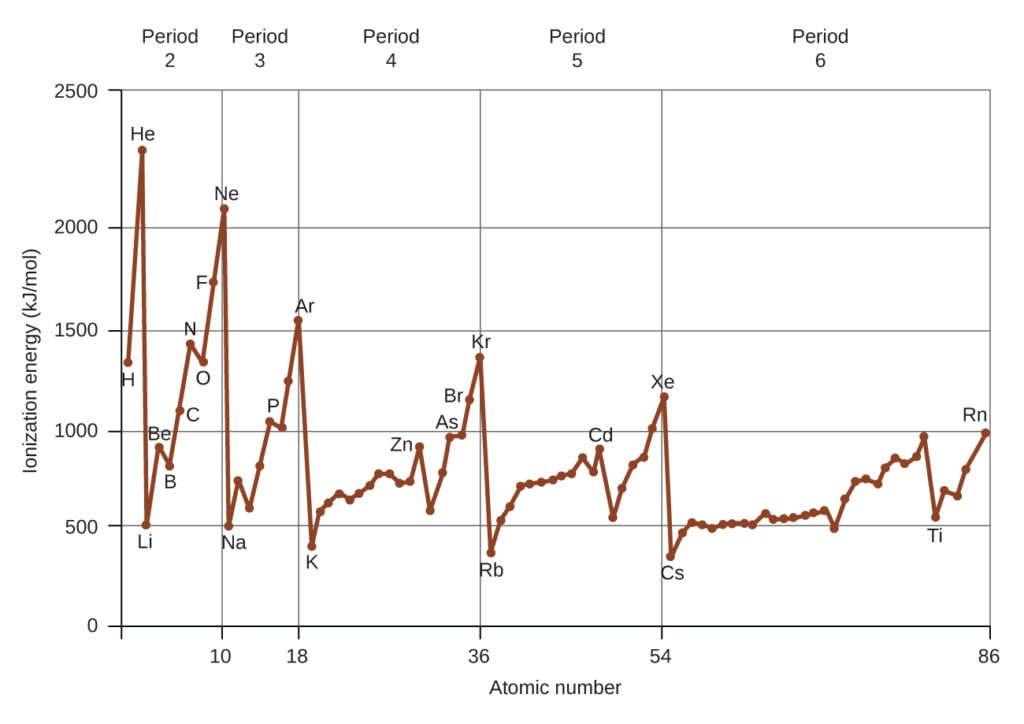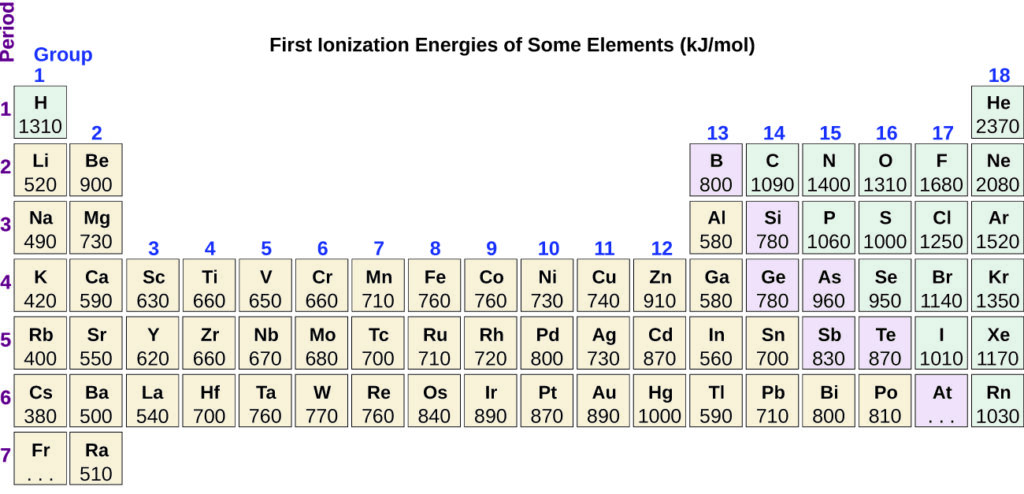The amount of energy required to remove the most loosely bound electron from a gaseous atom in its ground state is called its first ionization energy (IE1). The first ionization energy for an element, X, is the energy needed to form a cation with +1 charge: $$ X\: (g) \rightarrow \: X^+\: (g) + e^- \qquad \text{IE}_1$$
The second ionization energy (IE2) is the energy needed to remove the second most loosely bound electron : $$ X^+ \: (g) \rightarrow \: X^{2+}\: (g) + e^- \qquad \text{IE}_2$$
The energy required to remove the third electron is the third ionization energy, and so on. Remove electrons from atoms or ions always requires energy, so ionization processes are endothermic and have positive IE values.
Ionization Enenergy Trends and Deviations
For larger atoms, the most loosely bound electron is located farther from the nucleus and so is easier to remove. Thus, as size (atomic radius) increases, the ionization energy should decrease. Relating this logic to what we have just learned about radii, we would expect first ionization energies to decrease down a group and to increase across a period.
Figure 1 graphs the relationship between the first ionization energy and the atomic number of several elements. Figure 2 shows the values of the first ionization energy for the elements.
Within a period, the IE1 generally increases with increasing Z.
Down a group, the IE1 value generally decreases with increasing n.
There are some systematic deviations from this trend, however. Note that the ionization energy of boron (atomic number 5) is less than that of beryllium (atomic number 4). This is despite boron’s nuclear charge being greater by one proton.
We can explain this because the energy of the subshells increases as l increases, due to penetration and shielding (as discussed previously in this chapter). Within any one shell, the s electrons are lower in energy than the p electrons. This means that an s electron is harder to remove from an atom than a p electron in the same shell. The electron removed during the ionization of beryllium ([He]2s2) is an s electron, whereas the electron removed during the ionization of boron ([He]2s22p1) is a p electron. This results in a lower first ionization energy for boron, even though its nuclear charge is greater by one proton. Thus, we see a small deviation from the predicted trend occurring each time a new subshell begins.


Deviation of Ionization Trends and Cation Effects
Another deviation occurs as orbitals become more than one-half filled. The first ionization energy for oxygen is slightly less than that for nitrogen, despite the trend in increasing IE1 values across a period. This is due to the electron-elelctron repulsion caused by pairing the elctrons in the 2p orbital of oxygen. Removing one electron form oxygen will eliminate this repulsion. as a result, the orbital becomes half-filled, which is energetically favorable. Analogous changes occur in succeeding periods (note the dip for sulfur after phosphorus in Figure 2).

Removing an electron from a cation is more difficult than removing an electron from a neutral atom. This is due to the greater electrostatic attraction to the cation. Similarly, removing an electron from a cation with a higher positive charge is more difficult compared to a lower charge one. Thus, successive ionization energies for one element always increase.
Check Your Learning
Which has the lowest value for IE1: O, Po, Pb, or Ba?
Answer:
Ba